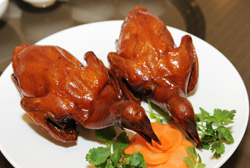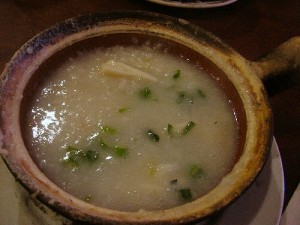August 21st, 2011 § § permalink
HG loves Canada. The cities. The farmlands. The mountains. The waters — the Atlantic and the Pacific and everything in between. Most of all, the people. Sane. Rational. Accepting. Of course, HG is most influenced by the fact that that BSK, the love of HG’s life, is a Canadian.
SJ informed HG today that Canadian food is having “a trendy moment in New York.” (see Robert Sietsema’s fine Article on the Subject HERE)HG is puzzled. Of course, there is wonderful food in Canada and chefs who take advantage of great seafood, beef, lamb, organic vegetables. Vancouver, Toronto and Montreal are world class foodie cities. But, the predominant influence in Vancouver is Asiatic. Toronto is international and eclectic. Montreal is very French, of course, but there are Jewish influences and some restaurants that feature hefty Quebec dishes (a lot of fat and maple syrup as befitting a climate that can get super chilly). The only uniquely Canadian food HG knows is poutine, a mixture of cheese curds and gravy usually served over French fries. It is ubiquitous in Montreal and the entire Francophone region. It is even on the menu at McDonald’s. How does it taste? Vile. Montreal gourmets are proud of Montreal bagels (totally inferior to New York’s H & H product). They also tout Montreal smoked beef, mentioning it as a competitor of New York pastrami.They must be kidding.
HG’s favorite taste of Canada is the huge array of oysters at Rodney’s Oyster Bar (Vancouver and Toronto). Perfectly shucked. Served with freshly grated horseradish. Nicely priced wine list. Canada at its natural, unpretentious best.
August 8th, 2011 § § permalink
HG refers to the squab, HG’s favorite little bird. Better than a baby chicken, a duckling, a quail or (usually tasteless) Cornish Game Hen. The squab is a domestic, farm raised pigeon. Succulent. It was a staple on New York restaurant menus often served with wild rice or stuffed with shallots, mushrooms and other attractive things. Alas, it disappeared as diners became oddly squeamish regarding small birds.
It remained, however, alive in barbecue form in some Chinatown restaurants. The best version of Chinese-style squab can be found at the Sun Sui Wah restaurant in the Mt. Pleasant neighborhood of Vancouver, Canada. This is a dark brown bird — served whole of course — with lacquered, crackling skin. HG liked to bite the bird’s head off much to the consternation of HG’s sensitive dining companions.
HG’s most memorable squab was consumed at the Au Bon Acceuil bistro
(near the Eiffel Tower) in Paris. Slices of rare roasted squab were fanned out over a pungent, dark red wine sauce. A bit of watercress added a touch of green. It was accompanied by a creamy, buttery potato puree. HG ate this in November a few years ago with a bottle of very fruity just arrived Beaujolais Nouveau. A nice Paris interlude.
Join HG in wishing for a return of squab to the better dining tables.
March 16th, 2011 § § permalink
Congee is the Queen of Comfort Foods. Soothing. Nourishing. Savory. Infinitely flexible. Essentially, congee is rice porridge. Bears a close resemblance to soupy grits. Doesn’t sound like much. But, HG and hundreds of millions of Chinese can’t be wrong (and not just Chinese, but almost every Asian country has its own version of Congee) It is very yummy stuff, indeed. Very addictive. When the world has been treating you shabbily and Mom isn’t around, turn to congee for comfort.
Okay. How to make it? That very good food blog, Loulies.com, has a sure fire recipe for a big pot of congee. Here goes: 10 cups of stock (chicken or vegetable). Two cups of rice. Two tablespoons Chinese rice vinegar. Five slices of ginger. Tablespoon of kosher salt. Bring these ingredients to a boil. Reduce to a simmer and keep pot covered. Stir occasionally. Cook for one to one and 1/2 hours until it has a porridge-like consistency. Add more stock (or water) if it gets too thick.
Now, you can get creative. Add to your bowl some left over chicken (as HG mentioned in yesterday’s Spatchcocked Chicken Post). Give it a hit of sesame oil. Maybe some sriracha for heat and spice. Sliced scallions. Parsley and/or cilantro. HG likes to top it with Planter’s Salted Cocktail Peanuts (don’t knock it until you’ve tried it). When HG lived in Vancouver he dined often at Congee House, a perfectly named restaurant. HG watched patrons add black hundred year eggs, bok choy, shrimp, duck, roast pork, chicken feet and more to their steaming bowls of congee. As HG said: Congee is flexible. HG’s congee favorite: Buy some shucked oysters at a Whole Foods fish counter. Chop coarsely. Add to your congee with some parsley and a bit of soy sauce. You will be grateful to HG.


